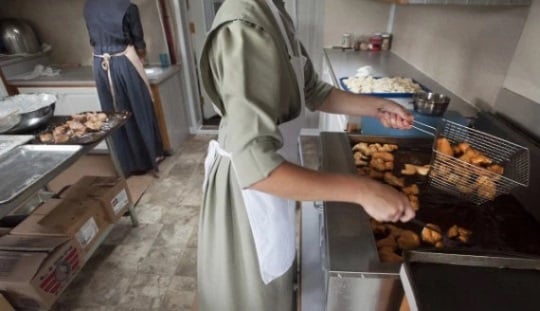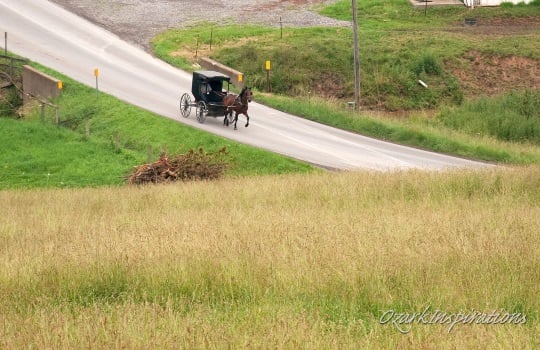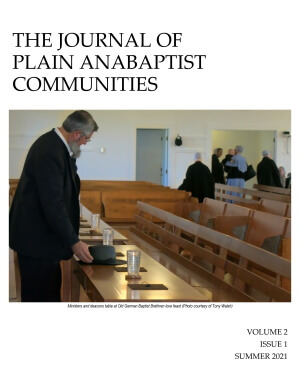New York Amish: Part 2 of Karen Johnson-Weiner interview and book giveaway
Today we continue with part 2 of our interview with SUNY-Potsdam Professor of Anthropology Karen Johnson-Weiner.
Karen is the author of the recently-released book New York Amish: Life in the Plain Communities of the Empire State. New York has proven an especially attractive destination for Amish in recent years, and is now home to over 12,000 Amish.
In today’s segment, Karen discusses how Amish migrants to New York have adapted economically.

She also shares insights on why some Amish settlements fail, and discusses prospects for further migration into the state.
If you missed the first part of the interview–or would like to know how to enter the book giveaway contest–go here: New York Amish interview, Part 1.
Karen Johnson-Weiner on the New York Amish: Part 2
Amish America: One recurring theme in your book New York Amish is the desire of many Amish migrants to preserve an agricultural lifestyle. How successful has this been for Amish settlers in New York? What difficulties have Amish encountered in seeking to maintain farming occupations?
Karen Johnson-Weiner: New York has offered Amish settlers access to cheap farmland, and most have thrived. They have had to create markets and adapt to a growing season that is shorter—and more challenging—than some have been used to. Many have become dairy farmers.
For Swartzentruber farmers, this has led to the acceptance of bulk milk holding stations—a change in the Ordnung that enabled young farmers to continue shipping milk even after the demise of the local cheese plant.

AA: In addition to agriculture, you detail the extensive business activity in some New York settlements. I particularly found interesting the Swartzentruber Amish quilters who embroider dates and initials, or produce NASCAR-style quilts for their English customers, design innovations they would not allow for quilts used in their own homes. In what other ways have New York Amish businesses adapted to their markets?
KJW: I mentioned the decision of the Swartzentruber communities to allow bulk milk holding tanks—a change, by the way, that is permitted only in those communities in which farmers don’t have access to cheese plants. Cheese plants are a market for grade B milk, which can be shipped in cans; bulk milk tanks allow the farmers to send grade A milk. Amish farmers in many areas have benefited from dairy cooperatives, in particular Dairylea and Agri-mark.

Adaptation has meant finding products that sell. Local Amish women are constantly trying new patterns for quilts—or sewing new items. Two come to mind—“quillows” (a quilt that fold up into a pillow—one local farm stand advertises these with a sign reading “great for college students”!) and handbags with a pieced design.

Amish men have turned to shed and gazebo making, harness shops, saddle making, and leather work. In upstate New York, the market for many of these items is in Canada. One man in the Mohawk Valley produces wooden toys that he markets in shops around New York.
Probably one of the most interesting adaptations to local markets is the Swartzentruber family that found assembling lacrosse sticks to be a lucrative enterprise—the entire family gathers around the table, eats popcorn and other snacks, and weaves the string netting onto the plastic frame. The youngest child burns the end of the nylon tie with a lighter so that the string won’t unravel.
AA: Despite the widespread success of Amish settlements in New York, not all communities thrive, and some in fact disband. What are some reasons Amish settlements in New York have faced challenges or failed?
KJW: Churches don’t start settlements, individual families do—and sometimes the new settlement just doesn’t catch on. It may be that the new settlement is too isolated from the parent community. Some settlements don’t make it because of personal conflicts within the community or because of disagreements over community practices. Others never really get started—just not enough families decide to move in.

Sometimes new settlements face environmental, personal, and economic forces external to the group that threaten the well-being of community members. For example, if a new community immediately runs into difficulty over local building codes and it doesn’t appear a compromise can be reached, many may decide it’s not worth the trouble to stay.
Some, like the first Amish to settle in New York State simply stop identifying as Amish—the settlement is still there (180 years later!), but it’s not an Amish settlement. Ultimately, whether a settlement succeeds or fails depends on circumstances that are peculiar to the group.
AA: Finally, is it likely that Amish immigration to New York will continue at high levels in future? What factors might influence migration into the state?
KJW: When Amish settlements grow too large and land prices climb too high, when there is internal conflict, or when events in mainstream society make life difficult, Amish families will move. And as long as farmland is available and the prices are reasonable, I think New York will be a popular destination, and the Amish will continue to come.

However, the decision to resettle in New York is very much a conservative one—by that I mean that the Amish who have come have chosen to remain farmers or have decided to refocus the economic base of their church on farming. Many could have stayed where they were and taken up other businesses (as has happened in Lancaster County) or modified their Ordnungs to permit new employment options.
These newcomers have chosen to act on the traditional Amish belief that farming is the ideal lifestyle for the Christian. This means that they are likely to be less willing to compromise on their faith and traditions—and more likely to come into conflict with local statutes and laws.
The more there is conflict, the less likely new settlers are to see New York as a destination. In my opinion, this would be a shame, for the diversity of Amish settlement further enriches New York State.
——————————————————————————————————–
Check back Thursday for the winner of New York Amish: Life in the Plain Communities of the Empire State. We’ll also be sharing an excerpt from the book. Read more on the New York Amish in the Amish State Guide, or find Amish woodworkers in the New York Amish furniture directory.






Awesome story!! Would love to read more. I have so much enjoyed reading about the NY Amish. Thanks for the articles and sharing this information with us. 😀
great story…enjoyed reading it and would love to learn more about the New York State Amish.
Once more, the diversity of jobs, ordnung rules, and types of Amish further differentiate this seemingly homogenous group. Thanks for the insights.
Glad everyone is finding part 2 as interesting as I did. Right now I am selecting a short excerpt to share from New York Amish on Thursday when I announce the contest winner.
Glad to read about Amish in New York State especially seeing I live in New York State. There are Amish near where I live. I use to just read about Amish in books-now they are our neighbors.
Enjoyed reading about the Amish in NY State. Very interesting and look forward to reading the whole book. Grew up in southern NY State and didn’t realize the Amish were in the upper part of the state.
A very interesting interview, and this sounds like an interesting book!
I find this so interesting. I hunger for more. I look forward to reading this book. I love learning so much about the Amish groups and their different ways of living among the Enghlishers. I am hoping to win this book. God Bless.. Liz
Part two is just as interesting. Would really like to leaqrn more.
CarolNWong(at)aol(dot)com
Do they pack the chips in kitty litter buckets too?
Glad everyone liked it. And in answer to your question dutch, somehow I doubt it 🙂
Did I miss the announcement of who won the book? I guess it wasn’t me, since I didn’t get notified.:(
Barn Raising
I’ve been invited to a barn raising on Wednesday at a Schwartzentruber farm in Newport, NY. This will be my first visit to an Amish farm.
Amish in NY
Where could I find amish people to get myself some saddle and tack built. I live on the border of Toronto and NY and somewehere closeby will be great help. Thank you.
Use google maps to find Conewango Valley, NY.
There should be someone there that can help you.
This might be farther away, but there is also a significant settlement of Amish in the Heuvelton/Rennselaer Falls area.